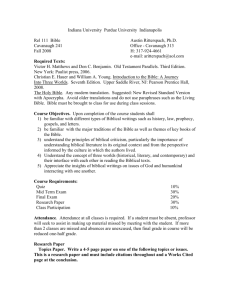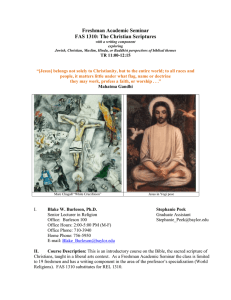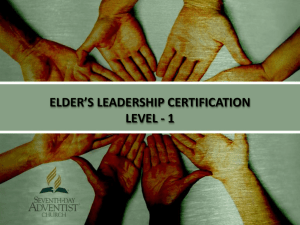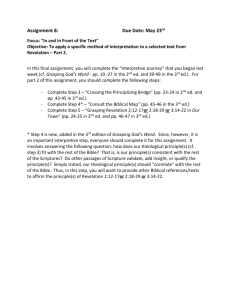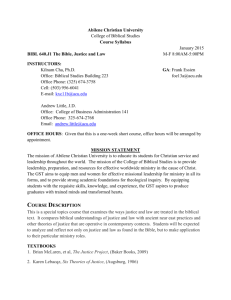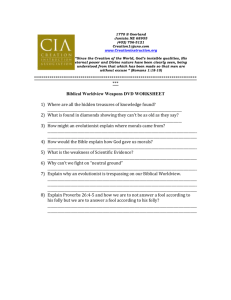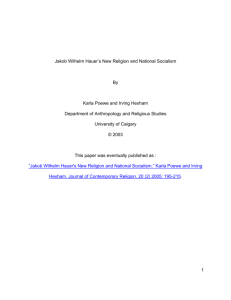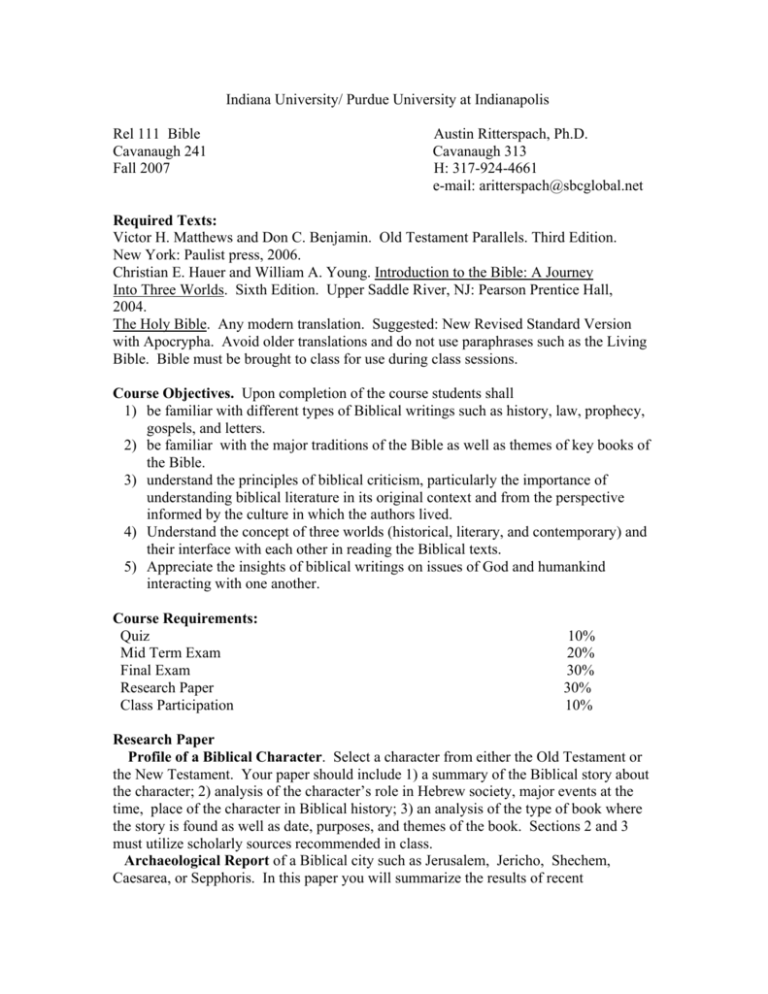
Indiana University/ Purdue University at Indianapolis
Rel 111 Bible
Cavanaugh 241
Fall 2007
Austin Ritterspach, Ph.D.
Cavanaugh 313
H: 317-924-4661
e-mail: aritterspach@sbcglobal.net
Required Texts:
Victor H. Matthews and Don C. Benjamin. Old Testament Parallels. Third Edition.
New York: Paulist press, 2006.
Christian E. Hauer and William A. Young. Introduction to the Bible: A Journey
Into Three Worlds. Sixth Edition. Upper Saddle River, NJ: Pearson Prentice Hall,
2004.
The Holy Bible. Any modern translation. Suggested: New Revised Standard Version
with Apocrypha. Avoid older translations and do not use paraphrases such as the Living
Bible. Bible must be brought to class for use during class sessions.
Course Objectives. Upon completion of the course students shall
1) be familiar with different types of Biblical writings such as history, law, prophecy,
gospels, and letters.
2) be familiar with the major traditions of the Bible as well as themes of key books of
the Bible.
3) understand the principles of biblical criticism, particularly the importance of
understanding biblical literature in its original context and from the perspective
informed by the culture in which the authors lived.
4) Understand the concept of three worlds (historical, literary, and contemporary) and
their interface with each other in reading the Biblical texts.
5) Appreciate the insights of biblical writings on issues of God and humankind
interacting with one another.
Course Requirements:
Quiz
Mid Term Exam
Final Exam
Research Paper
Class Participation
10%
20%
30%
30%
10%
Research Paper
Profile of a Biblical Character. Select a character from either the Old Testament or
the New Testament. Your paper should include 1) a summary of the Biblical story about
the character; 2) analysis of the character’s role in Hebrew society, major events at the
time, place of the character in Biblical history; 3) an analysis of the type of book where
the story is found as well as date, purposes, and themes of the book. Sections 2 and 3
must utilize scholarly sources recommended in class.
Archaeological Report of a Biblical city such as Jerusalem, Jericho, Shechem,
Caesarea, or Sepphoris. In this paper you will summarize the results of recent
excavations of the city. Resource books for this paper are on reserve in the library and in
the library’s reference room. This paper could also be written on one aspect of the Dead
Sea Scrolls, which is one of the most important archaeological discoveries of modern
times.
New Testament Gospel. This paper will deal with one of the canonical gospels.
Based on scholarly sources, this paper will analyse one of the gospels in terms of type of
literature, authorship, date, themes and purposes. It is important to discuss sources used
by all of the gospels and their relationship to each other.
Course Outline
I. Methods of Biblical Study. Geography of Israel and the Ancient
Near East
Aug. 22
Matt. 7:12
Gen. 2:4-3:24
Hauer and Young, pp. 19-20 (maps). Arnold, p. 18 (map)
.
II. Torah: Book of Beginnings
Aug. 29
Hauer, pp. 1- 60. Matthews and Benjamin, “Stories of Gilgamesh,” pp. 20-32
Arnold, pp. 15-19. “Enki and Ninhursag” (reserve)
Jos. 6. Num. 6:24-26 Gen. 1:1-3:24. Gen. 6-9.
QUIZ
Sept. 5
III. Major Biblical Traditions: the Ancestors, the Exodus.
Sept. 5
Gen. 12:1- 9; 28:1-17; 32:22-32. Ex. 1-3; 20:1-17. Deut. 26:5-10..
Hauer, pp. 70-98.
Arnold, pp. 72-73 (“Adoption of Shennima”), pp. 111-113 (reserve).
IV. Covenant at Mt. Sinai. Settlement in Canaan.
Sept. 12
Jos. 6. Jos. 24. Judges 4-5. (settlement)
I Sam. 10:1-17 II Sam. II. Sam 6:12-23. 7:1-14. I Kings 6-7. (united monarchy.)
Hauer, pp. 99-124.
Matthews and Benjamin, pp. 97-98. (“Annals of Merneptah”)
V.
Formation of the State of Israel. Covenant Advocates: the Prophets
Sept. 19
of Ancient Israel.
I Sam. 10:1-17. II Sam. 6:12-23. 7:1-14. I Kings 6-7 (united monarchy).
I Kings 21-22; II Kings 17. Amos 6:1-7; 7:1-17. Book of Hosea.
Jer. 7; 26:1-19; 31:31-34. Is. 7:1-25.
Hauer, pp. 126-142
Matthews and Benjamin, pp. 170-71, 193. (“Tel Dan Annals” and “Siloam
Story
VI. Fall of Judah. Prophets of the Exile.
Isaiah 40:1-45:7. Ezekiel 1-7; 40-48.
Hauer, pp. 143-150.
Sept. 26.
VII. Sacred Songs and Philosophical Wisdom.
Oct. 3
Hauer, pp. 151-83.
Book of Job. Eccl. 1-3; 7. Psalms 1,2, 23, 24, 117, 150.
Matthews and Benjamin, pp. 239-44 (“A Sufferer and a Friend in Babylon”).
VIII. Between the Testaments: Dead Sea Scrolls and Apocalyptic Literature Oct. 10
Book of Daniel. Hauer, pp. 195-222..
James Vanderkam, The Meaning of the Dead Sea Scrolls, pp. (reserve)
Mid-Term Exam
Oct. 17
IX. The Proclaimer and the Proclaimed: Jesus and the Gospel Writers
Oct. 24
Hauer, pp. 223-268..
Determining What Jesus Actually Said: Matt. 1-3; 16:13-20. Luke 4:16-30.
Lk. 15 (Parables. Lk. 11:2-4. Mt. 6:9-13 (Lord’s Prayer).
Lk. 6:20-26 and Mt. 5:3-12 (Blessings).
Unique Theology of a Gospel Writer: Mt. 21:1-11. Zechariah 9:9,
Mt. 27-28 Luke 6:20-26. Lk. 11:2-4. John 14-15.
X. Birth of Christianity; The Acts of the Apostles
Hauer, pp. 272-286.
Acts 2; 9:1-30.
Oct. 31
Nov. 7.
XI. Paul Writes to the Early Church
Hauer, pp. 287-310.
I Corinthians. Galatians.
Nov. 14
THANKSGIVING
Nov. 21-25
XII. Later literature and non-canonical books.
Revelation.
I, II Timothy Gospel of Mary (reserve), pp. 3-47, 69-81.
Nov. 28
XIII. Wrap Up and Review for Final
Hauer, pp. 311-332.
Final Exam
Dec. 5
Dec. 12.
“Of the making of many books there is no end, and much study is a weariness of the
flesh.”

